This 1957 Ford Country Sedan Station Wagon Hides a Factory Supercharged Surprise
03/10/2024

Photography by Eric English
Classics
People who view this 1957 Ford Country Sedan for the first time are often impressed by its generally unrestored condition and appealing original color combination. They’re not wrong of course, but the real appeal of this vintage wagon is under the hood, which is in fact sometimes missed. “It’s so unexpected,” owner Frank Stubbs says, when explaining the reaction people give him after learning of the factory supercharged status of the car. “Most people have no idea that Ford offered a supercharger on the ’57s at all, much less on a four-door station wagon. They’re blown away by the idea.” But of course, Ford did offer just such an animal, and this may be the only one of its kind.
Not wanting to assume that all our readers are experts on factory blown 1957 Fords, here’s a quick recap. In a case of racing making the breed better, the ’57 model year dawned with multiple manufacturers scrambling to homologate new equipment in hopes of improving their competitiveness in NASCAR stock car racing. Ford arguably pushed the envelope the most by fitting a McCulloch centrifugal supercharger to their 312-cu.in. Y-block engine, making it available across the Ford fleet. Chevrolet debuted a fuel-injected 283-cu.in. V-8 for the same reason. Things were getting exciting until April of ’57 when NASCAR decided to limit induction to a single normally aspirated four-barrel carburetor, followed in June by the mutual Automobile Manufacturers Association (AMA) ban on factory-supported racing.
Photo by Eric English
The 1957 Ford is an attractive design, and yet dwarfed in popularity today compared to the ’57 Chevy. Would you believe the ’57 Ford actually outsold the ’57 Chevy by a narrow margin? In fact, it was the only year during the decade in which Ford beat Chevy in passenger car sales.
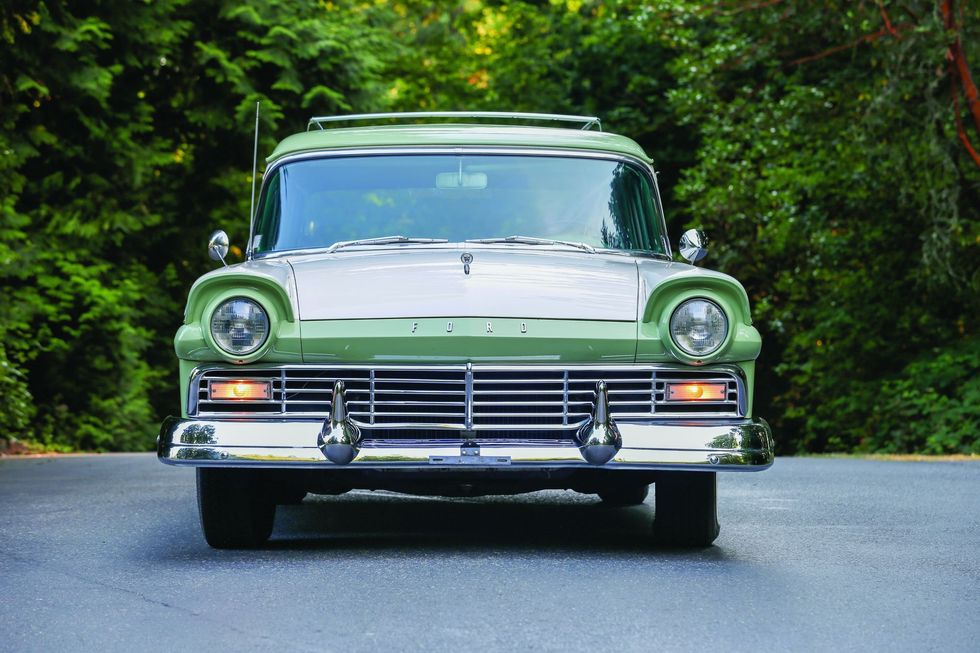

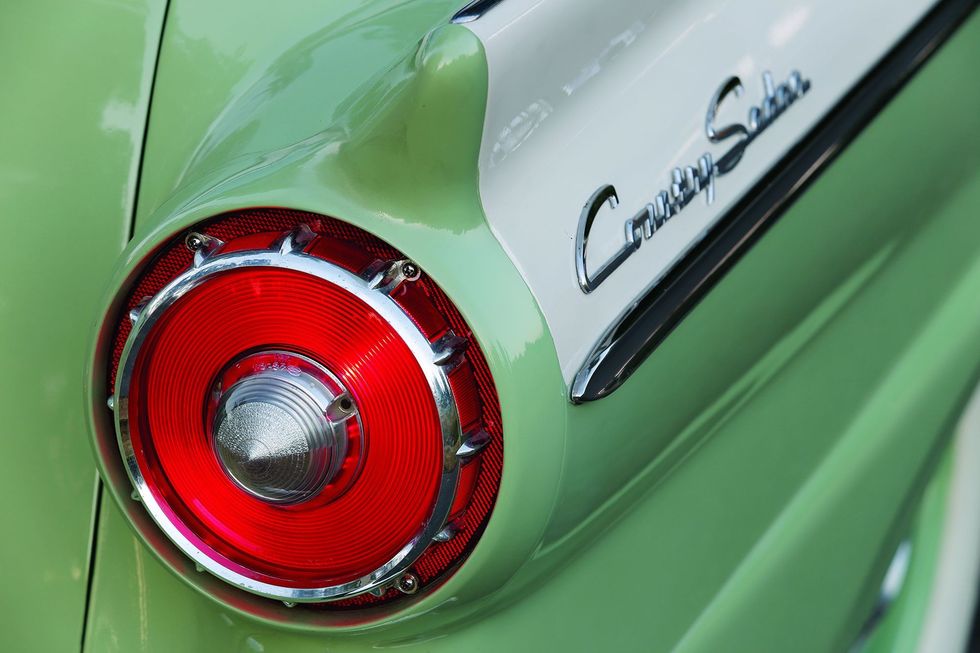
Nevertheless, the cat was out of the bag and supercharged Fords were showing up on the streets across America. The supercharged 312 was rated for 300 horsepower in street guise - 55 horses more than the “Thunderbird Special V-8” four-barrel 312, and 30 more than the “Thunderbird Super V-8” dual four-barrel 312.Supercharged equipped Fordshave since become known as “F-code” cars as the first digit of the VIN–the engine identifier position–is an “F.” It’s worth noting that four-barrel 312 cars had a “D” in the first position and dual-quad 312s had an “E” in the first position–thus an “E-code” identity amongst enthusiasts. It’s also worth noting the F-code V-8 replaced the E-code during the model year. It’s thought that anywhere between 1,000 and 1,500 production cars in total were turned out with the blown Y-block–211 of them being Thunderbirds.
Frank Stubbs knows a thing or two about F-code 1957 Fords, as he’s the registrar for the F-code Thunderbird and F-code Ford registries. Additionally, during his career as the man behind Frank’s Restorations, he’s restored six F-code Thunderbirds and several other Ford F-code passenger cars. Currently he and Cathy own six supercharged ’57s, including the Phase 1 Thunderbird and F-code Skyliner featured in tandem in the April 2006 issue of our sister publication, Hemmings Muscle Machines. As to the Country Sedan wagon seen here, Frank and Cathy have owned it since 2000.
Photo by Eric English
Proud parents have the right to brag, right? Frank and Cathy’s son, Kyle, is a graduate of the USCG Academy in New London, Connecticut.
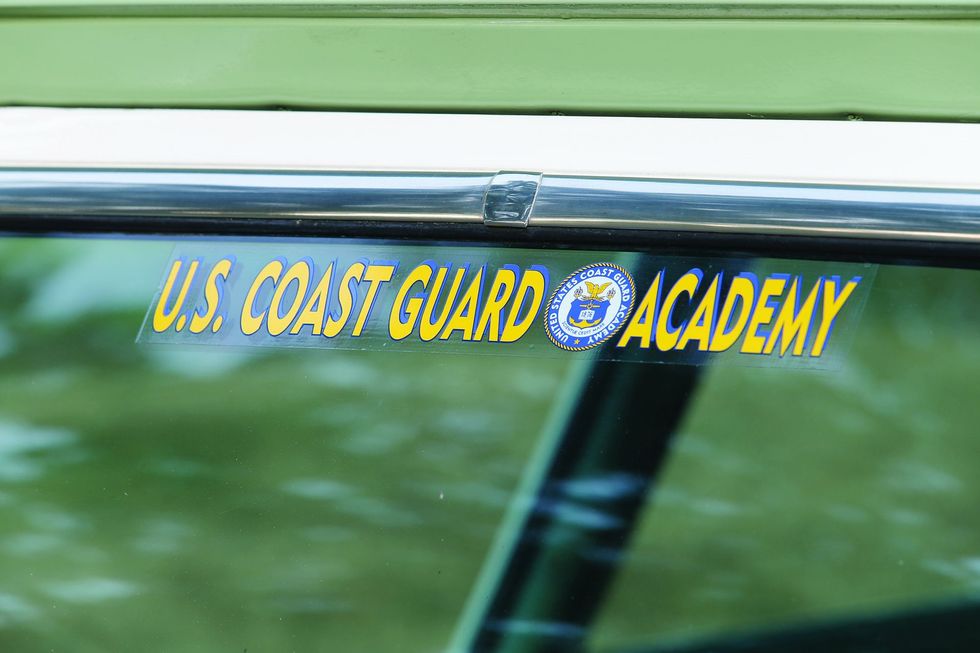
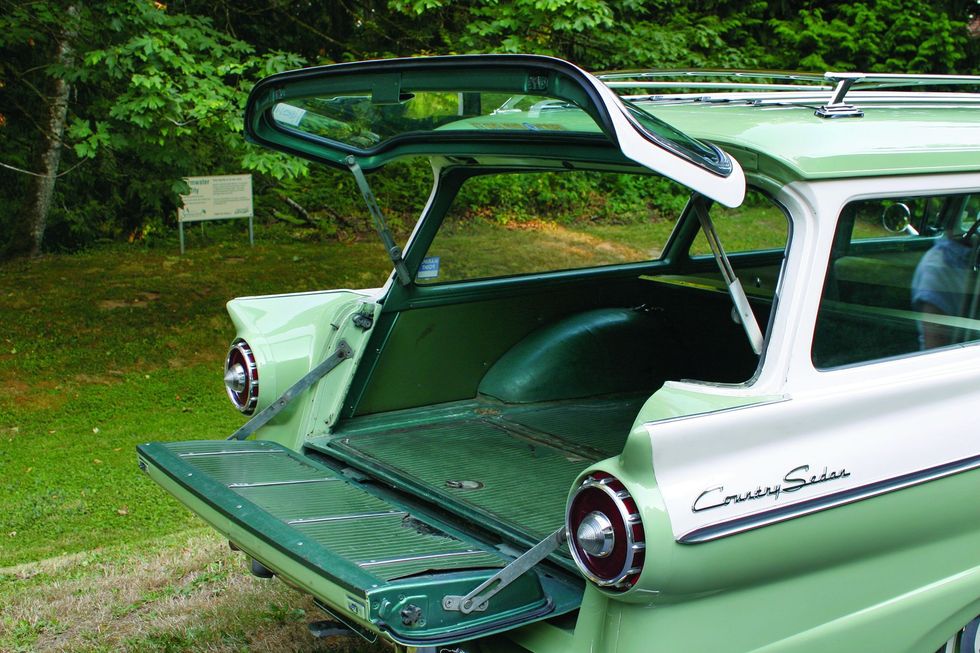


In all his travels and contacts in the Ford world, this is the only F-code 1957 Ford wagon Frank has uncovered. As a result, rare seems to somehow be an inadequate term when describing this car, and that’s where the incredulous nature of some people’s reaction to it comes into play. Frank does add that banter in the F-code enthusiast world is that his wagon is unlikely to have been the only one ever built, and that a handful of wagons probably did see F-code engines. Unfortunately,it’s pure speculation, as specific records simply don’t exist.
Fortunately for Frank and Cathy, there is a fair bit of history documented regarding their wagon, much of it courtesy of the prior enthusiastic owner, Jerry Torcyzner. “I knew Jerry through the network of F-code enthusiasts, in fact I bought my ’57 Phase 1 Thunderbird from him around 1990,” Frank says. “Even though he was in California, and I lived in Washington, I’d seen the wagon several times over the years and thought it was pretty cool. Jerry unfortunately passed in the late ’90s, and his family was left to dispose of his assets. His mom had his cars appraised, and the appraiser got in touch with me to ask some specific F-code questions. The appraiser also told me she was getting ready to sell it, so when he finished the task, I gave her a call and we worked out a deal.”
While Frank didn’t have an opportunity to talk to Jerry about the wagon, Jerry had written a historical narrative of the car and had the original dealer invoice, both of which offered valuable information. According to Jerry, he’d been a Ford enthusiast since the late Fifties, and was first introduced to the ’57 blower cars when he and friends were hanging out at Half Moon Bay Dragstrip in 1964. There, he saw Larry Walker racing a D/Stock ’57 supercharged Ford Custom and became hooked on F-codes. Jerry soon found himself racing a supercharged ’57 Custom and raced with Walker and several other enthusiasts at a variety of Central and Southern California tracks. He related that in 1969, he heard a couple reports of a supercharged station wagon in the Atascadero area but didn’t believe it. Shortly thereafter, Jerry was led to the car, which at the time was owned by a used car dealer. Though the supercharger itself was missing, Jerry saw the “F” in the VIN and realized the Ford was indeed factory supercharged. It took a bit of time, but Jerry eventually talked the owner into selling the wagon.
Photo by Eric English
The interior in this Country Sedan is largely unrestored, save for a headliner and seat upholstery.
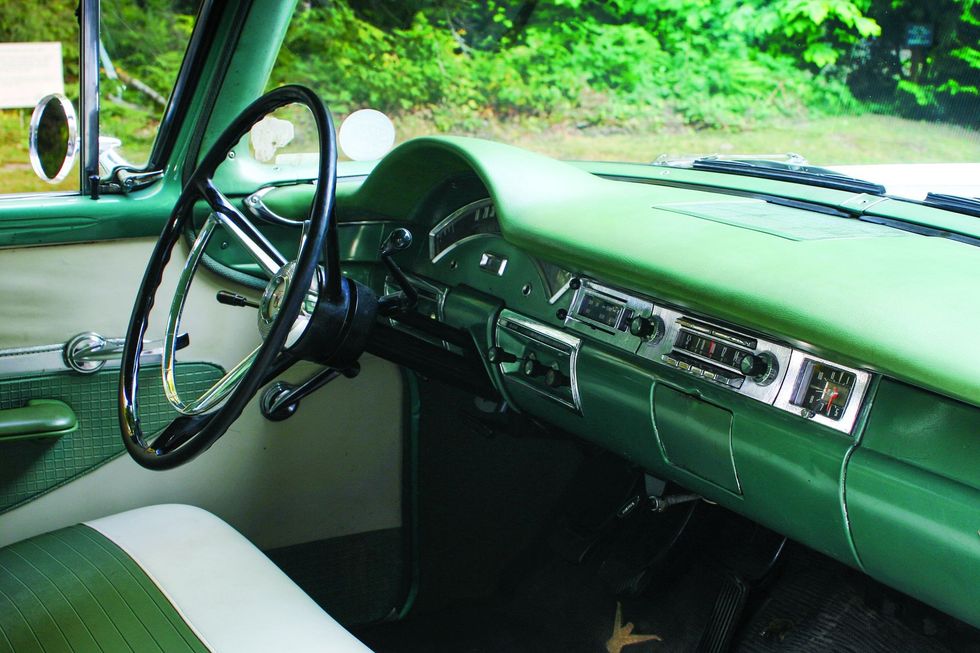
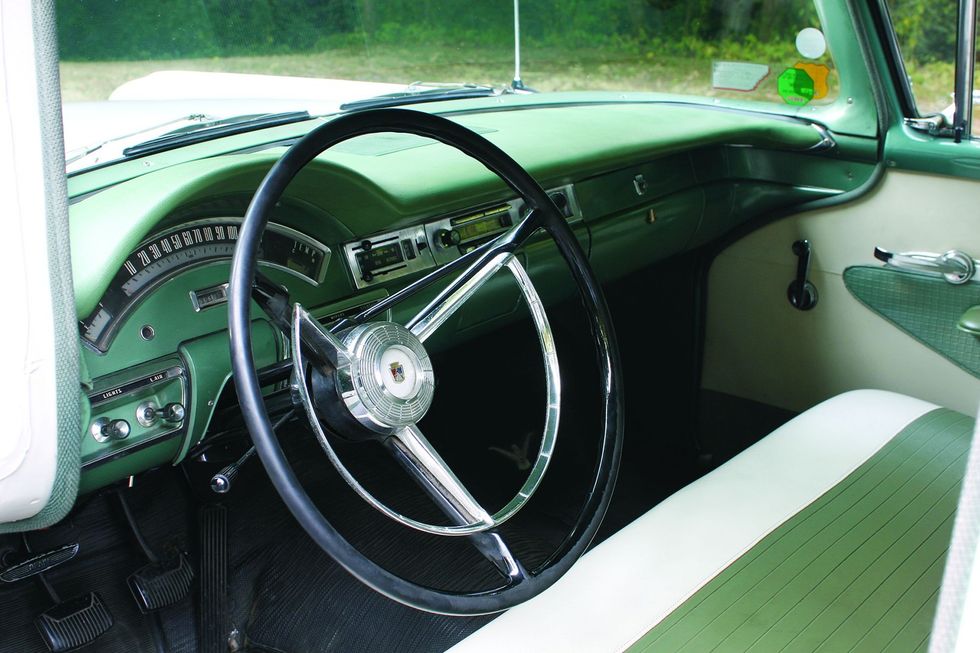
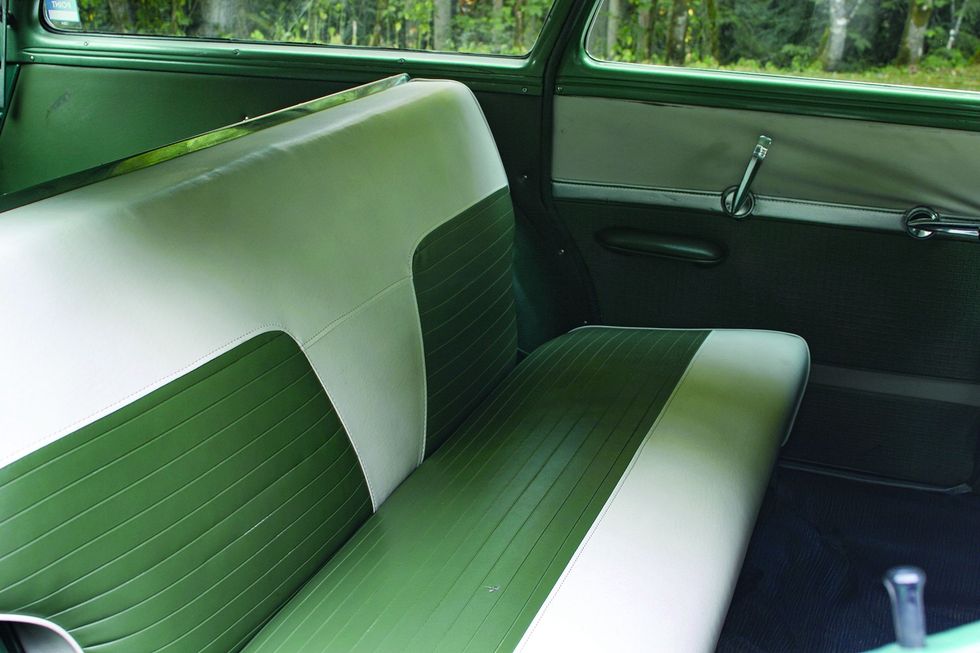
According to Jerry’s write-up, the car still had the original cylinder heads, intake manifold, pulleys, and other F-code specific items when he bought the Country Sedan in December 1969. He also claims to have found the original supercharger in a dairy farmer’s yard and reinstalled it on the car. The next bit of our story comes from Jerry’s missive itself. “I traced the car to the original owner. The car was ordered in December 1956, but not delivered until August 1957, just barely before the release of the new models. The original owner was a truck driver and had gone to Atascadero Ford in December 1956 and requested the most powerful engine they had to tow a boat or trailer over the steep Sonora Pass near Yosemite (9,624 feet). They ordered the car with the just announced 300-hp option. The original owner told me he would tow up the grade and pass other cars that couldn’t make it up because of low power or overheating. He’d be going 80 mph up the mountain. The second owner was a dairy farmer that raced cars on dirt ovals. He told me he used to tow down Highway 99 doing almost 100 mph.”
Though Jerry’s narrative doesn’t specifically say, it seems logical that the dairy farm where Jerry snagged the original blower was the second owner’s farm. Jerry also noted racing the wagon now and then, with specific references to the 1969 Winternationals where he apparently won his class, and the 1970 March Meet/Bakersfield Gas and Fuel Championship in California.
While Frank and Cathy have enjoyed owning the wagon for the past 23 years, Frank has been surprisingly restrained in what he’s done to it.“The car was a good driver when we got it, so we’ve mostly just enjoyed it. It was hit in the front at some point when Jerry owned it, and when it was repaired, the car got a full repaint in its original Willow Green and Colonial White two-tone. Unfortunately, the work also included replacing the damaged trim spears on the front fenders with incorrect Fairlane trim, which presented a slight mismatch where the trim transitions to the doors. It took me awhile to find nice correct spears, but I eventually replaced them. I also replaced the headliner, and of course general maintenance items. That’s really all I’ve ever done to it.”
With Frank and Cathy’s other F-codes restored to a high level, the couple finds this wagon a great car to take anywhere, anytime. Nice as it is, they simply don’t worry much about potential damage, though to be sure, the ’57 is irreplaceable. And even better, there’s room in the back to handle the equipment for any occasion, which these days is mainly folding chairs and a cooler for car shows and cruises. In the end, it’s safe to say that the days of pulling a trailer up high mountain passes are long gone, but the Stubbs’ remarkable supercharged wagon continues to impress.
Photo by Eric English
F-code Fords could be had with both manual and automatic transmissions. The Stubbs’ wagon has a three-speed manual and was also originally fitted with a Borg Warner overdrive unit. Blowers on manual-shifted cars received the double V-belt drive pulley seen here, whereas automatic applications had a single belt pulley.
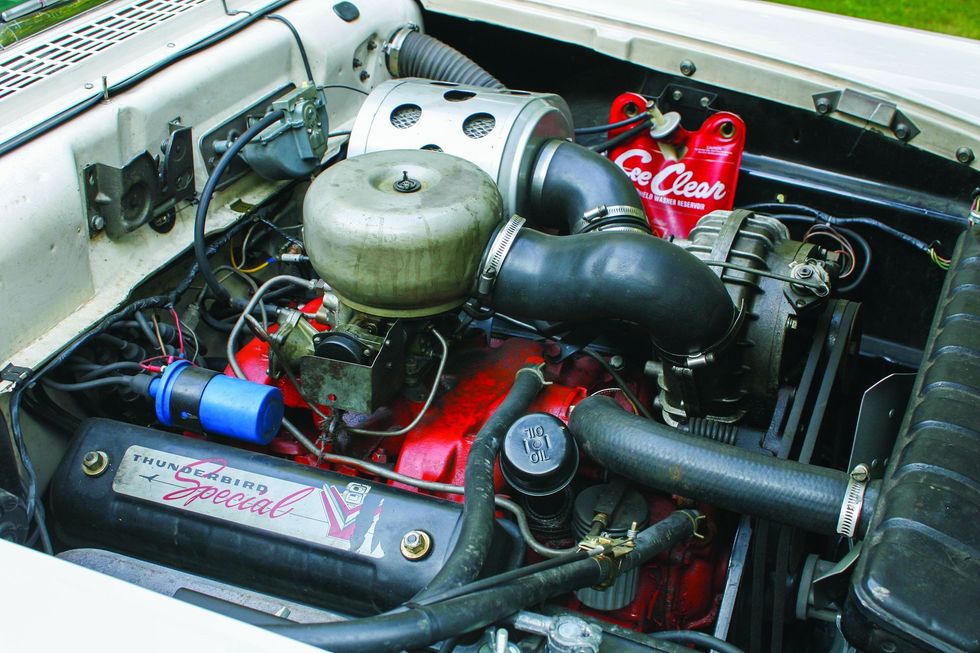
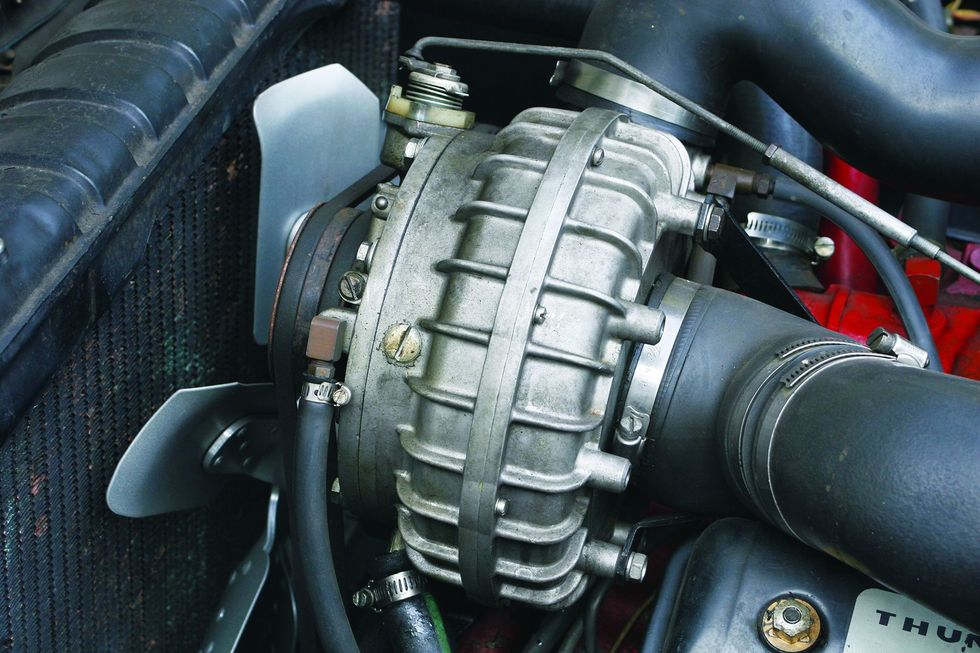
Robert Paxton McCulloch (1911-1977), was an engineer, entrepreneur, and successful businessman. Through the heart of the 20th century, he created several manufacturing companies, including the McCulloch Engineering Company, McCulloch Motors Corporation, McCulloch Aviation, Paxton Engineering, and Paxton Products. These companies built a variety of industrial products, some under military contract, that includedsmall engines, portable pumps, chainsaws, helicopters, gyroplanes, and of course superchargers.
In the early Fifties, Paxton Products designed a new variable speed ball-drive supercharger known as the McCulloch VS57. It was met with enthusiasm by hot-rodders who adapted it to a variety of domestic engines, and it was in fact used in some factory Kaiser and Studebaker applications. Shortly thereafter, Paxton developed yet another automotive blower, this one with an internally controlled variable ratio instead of a variable speed external pulley. It was funded by Ford in mid- to late-1956 with the intent of putting it into regular production for ’57 model-year Fords. This unit is known as the McCulloch VR57, and Phase 1 versions were assembled in time for the 1957 Daytona Speed Trials in February. Within months, further revisions to the VR57 resulted in the Phase 2 blowers used on production F-code cars.
Questions relating to the correct attribution for VS and VR blowers of this era have long existed, with some calling them McCullochs, others McCulloch/Paxtons, and others Paxtons. We know that Paxton Products was established in 1950 and did the design and engineering for both superchargers, so where does the McCulloch name enter? It’s possible that McCulloch may have done the actual manufacturing, and a good clue to this can be found in the 11/26/56 Ford letter found elsewhere in this story. It states, “McCulloch Motors will require approximately five and one-half months to tool for this supercharger but could produce units on a hand-made basis within approximately ten weeks.” What’s clear is that the companies themselves identified the blowers as McCulloch during this timeframe, and that’s good enough for us. Paxton Products was sold to the Granatelli brothers in 1958, and subsequent products were clearly known by the Paxton name.

Photo by Eric English
What was thought to be the last Chevrolet Camaro rolled out of the factory in late-2023, but the model’s nameplate may not be on hiatus for long. General Motors president Mark Reuss reportedly wants to see the Camaro make a comeback as an affordable EV.
According to Motor Trend, Reuss has a vision to create a budget-friendly four-door electric vehicle under the Camaro muscle car nameplate. The approach would be somewhat similar to Ford’s Mach-E, except instead of offering an electric crossover alongside gas-powered coupe and convertible Mustangs, the Camaro would retain its sedan body style. The future electric Camaro is unlikely to be offered in a coupe or convertible version due to engineering complications for the EV platform and low sales numbers for two-door cars, which wouldn’t justify the extra expense.
While most Americans recognize the Camaro as a burly muscle car, Reuss reportedly wants the next generation of Camaro to go back to the model’s roots as a simple and affordable vehicle.
The estimated cost for a Camaro EV sedan could be similar to the current MSRP of a Chevy Equinox EV crossover which starts at $34,995. By adding an EV Camaro to its electric vehicle lineup, Chevrolet will have several affordable EVs available in the near future, including the return of the Chevy Bolt.
Despite Reuss’s desire to re-focus the Camaro EV on practicality and affordability instead of performance and high-horsepower numbers, it’s important to note that none of this news is formally part of GM’s production plan. With nothing yet set in stone, there’s still a glimmer of hope that we may still see a next-gen Camaro with bigger performance options.
General Motors announced that the Chevrolet Malibu will cease production by the end of the 2024 model year following several years of scaled back production and slowing sales. The once-iconic car was first introduced in 1964 and garnered 10-million models sold in its lifetime.
The Chevrolet Malibu got its start as a luxury trim level on the classic Chevelle model and quickly carved out its own identity in the automotive industry over nine generations. Production ended once in 1983, but GM brought the Malibu back in 1997. It was once the top-selling midsize sedan in the United States and a common sight in family garages across the nation. Beginning in the early 2000s, sales began to decline as SUV and pickup truck sales began to skyrocket.
Today, the automotive market is dominated by full-size trucks and SUVs, with the Ford F-Series lineup, the Chevrolet Silverado, and Toyota’s RAV4 ranking as the top sellers for 2024 so far. Midsize cars earned only 8-percent of new U.S. vehicle sales in 2023, including the sale of just over 130,000 Chevrolet Malibu models. The last recorded increase of sale for the Malibu took place in 2016 after the model year’s redesign, but it is speculated that many of those sales were low-profit and went to rental car companies.
The Malibu is Chevrolet’s last sedan as the brand focuses on hybrid and electric SUVs and trucks. The Chevrolet Corvette could be the bowtie’s last surviving car model for the time being since the last Camaro rolled off the assembly line late last year, but the Camaro could be making a comeback in EV form.
So what vehicle is replacing the long-lived Chevrolet Malibu? GM states that the Kansas assembly plant will cease production of the Malibu sedan in November of 2024. The future model to replace the Malibu production line will be the next-generation Chevy Bolt EV, which GM said is coming in 2025 or 2026, likely in the form of a compact SUV or crossover hatchback. The Fairfax Assembly plant will reportedly receive $390 million in updates for its future model production, which also includes the Cadillac XT4 SUV.
The phrase “they don’t make them like they used to” rings true to the Chevrolet Malibu. Check out the fleet of classic Malibu’s listed on Hemmings Marketplace.